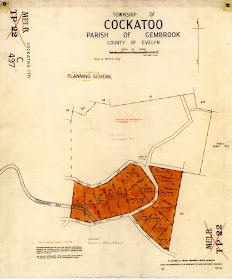You may be aware that is 150 years since Cranbourne was officially proclaimed as a township and that celebrations are planned for later in the year. This is a great milestone and well worth celebrating, however it does bring up the question as to old your town really is and what do we actually use as the ‘start date’
We could use the dates in the Victorian Government Gazette, which covers all official notifications of Government and Legal activities and was the main way that the Government communicated with the Public. The first mention of Cranbourne in the Gazette
was on October 31, 1855 when Alexander Duff was appointed Deputy Registrar of Births and Deaths for the Cranbourne and Dandenong District. On October 23, 1856 Trustees were appointed for the land set apart at Cranbourne for the use of the Presbyterian Church – these Trustees were Alexander Cameron, Patrick Thompson, Alexander Patterson, James Leckie and Angus Kennedy.

Victorian Government Gazette dated Friday October 24, 1856, Issue 137, Page 1786.
Two years later on November 29, 1858 The Right Reverend James Goold, The Reverend Patrick Niall, Edward Malloy, Terence O’Connor and James Feehan were appointed Trustees for the site for a Roman Catholic School at Cranbourne.

Victorian Government Gazette dated December 3, 1858, Issue 164, Page 2445.
The Trustees which were appointed for the Cemetery site on December 11 1857 were Alexander Cameron, Patrick Thomson, James Smith Adams, William Sykes and Edward Malloy. Niel Gunson writes in his book Good Country: Cranbourne Shire that Cranbourne was surveyed by H.B Foot in 1852 and the Cranbourne township was ‘reserved’ and that the township lots were surveyed in 1856 and the first sale of town lots held March 25, 1857. The Cranbourne Road Board was proclaimed on June 19, 1860. All these events took place before the township was officially proclaimed on February 25, 1861.
A similar story can be seen at Berwick where the first mention in the Government Gazette was February 9, 1859 when Trustees were appointed for the site of the Roman Catholic School – once again the Right Reverend J. Goold, the Reverend Patrick Niall and Terence O’Connor were appointed as was Edward Malloy and James Feehan. On March 12, 1860 Matthew Brisbane was appointed a Deputy Registrar of Births, Deaths and Marriages for Berwick. July 25, 1860 Charles Rossiter, James Feehan, John Brisbane, Abram Gardiner and Adam Ritchie were appointed Berwick Cemetery Trustees.
 Victorian Government Gazette dated August 3, 1860, Issue 95, Page 1440.
Victorian Government Gazette dated August 3, 1860, Issue 95, Page 1440.
The book Early Days of Berwick states that the Berwick District, like Cranbourne, was surveyed by H. B Foote in 1852. In 1857 the Berwick Branch of the Mornington Farmers Society was established, the same year the first show was held at Cranbourne. As you can see all these events happened before the township was officially proclaimed on February 25, 1861.
In fact February 25, 1861 was a day when 188 townships were proclaimed – other Casey Cardinia towns (or close neighbours) were Buneep (the old abandoned town on the Bunyip River which would now be considered Tonimbuk), Dandenong, Emerald, Lyndhurst and Pakenham. So Happy Birthday to all these towns and in the end it doesn’t matter what date we use to signify the start of our towns – the important thing is that we preserve and celebrate our history.
 ity spirit which built our towns and organizations.
ity spirit which built our towns and organizations.






